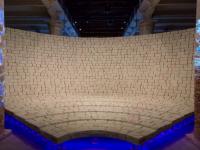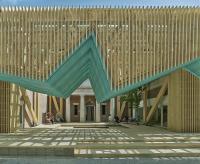Twosome Inn
Beijing, China
The project is located in Tangdazhuang Village in Tongzhou District, Beijing is a village that preserves the traditional northern flat house architectural style. The houses here are made of red bricks and have elements of ancient Chinese architecture such as painted patterns, wooden structure sloping roofs, and other traditional features. Extracting and reconstructing these traditional architectural features is a challenging design task. Atelier d’More was commissioned to transform a small flat house and courtyard, with a total area of only over 80 square meters, into a boutique hotel, injecting new modern geometric elements into the original architectural and site characteristics, reshaping the architectural context, and practicing a new imagination of traditional architecture.
In this transformation, we hope to preserve the traces of traditional architecture and give them new meaning in a modern context. We retain the classic elements of the eaves while simplifying the painted patterns, making traditional elements an abstract expression throughout the entire building.
In order to infuse the space with soul, we extracted the red color from the original architecture and made adjustments to its hue. We defined it as the main tone of this project, transforming the color from a mere visual experience into a spiritual expression. It is tastefully integrated in appropriate proportions throughout the facade of the building and the interior furniture, acting as a subtle note that brings a poetic atmosphere to the entire project.
We introduced a main axis in the courtyard, delineating several branching paths in curved forms, creating four distinct internal courtyards. This arrangement not only creates a sense of spatial hierarchy visually but also achieves flexibility and adaptability in terms of functionality. The landscape area paved with red volcanic stones adds a touch of elegance to the architecture, while the cement pathways flow towards the different guest room spaces, guiding guests in their direction and spatial range.
Furthermore, we designed the entrance of the guest rooms with tension-filled geometric shapes, creating a unique entrance ritual with a touch of local charm. After removing the walls that originally faced the courtyard, large floor-to-ceiling glass windows replaced the relatively enclosed window-wall system, blurring the boundaries between the outdoor courtyard and the indoor space. This way, the outdoor courtyard and the indoor space become alternating landscapes, seamlessly connected and offering captivating views.
We strive to showcase ancient rhythms within a modern context and allow the coexistence of time's memories through spatial design. Under the sloping roofs of the existing buildings, we opened up the ridge section to reveal the original wooden beams. We also made changes to the roof profile relationship, using curved surfaces to outline the traditional sloping roof image. This integration of ancient architectural language into modern space ensures the inheritance of history within the contemporary setting. In this 4.1-meter high space, we have designed soft indirect lighting. Each beam of light outlines the contours of the space, providing a spiritual experience within the environment.
This project has been one of the most challenging small-scale projects we have undertaken so far. One major issue that has posed a challenge is that the client did not hire a professional construction company but instead employed laborers for the construction work. This has made it difficult to control the skill level and commitment of the workers, causing significant challenges in terms of the project's completion. After experiencing a series of construction errors, we made a decision to intervene more deeply in the construction process through design means in order to minimize the chances of mistakes by the construction team.
We designed all the interior furniture and cabinets to be prefabricated and assembled. Whether they are visible components or hidden framework, every piece of wood is precisely positioned in its designated location. This approach liberates the construction workers' minds, as they simply need to follow the assembly drawings provided by us, ensuring that the final result aligns with the design drawings.
This design strategy not only reduces errors and uncertainties during the construction process but also improves construction efficiency. It stems from years of practical experience and design techniques in our studio. We have simplified traditional joinery techniques and applied them to furniture assembly, not only for functional purposes but also as an expression of aesthetics and artistry, aligning with the style and concept of the project itself.


















































